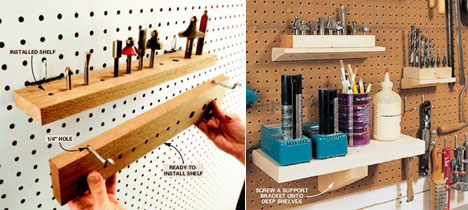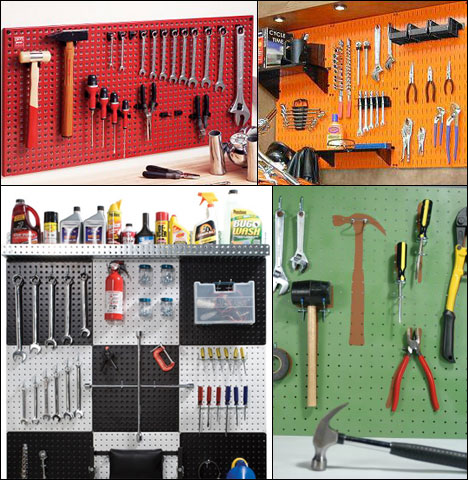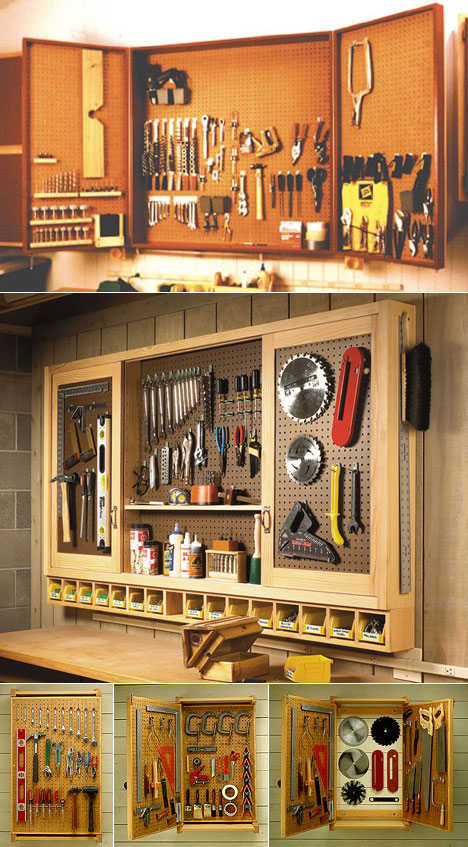The basics of tool organization systems, Part 1: Pegboard

I've got a thing for tool storage, which directly reflects my organizational failings in other areas of my life: I have no hope I'll ever be able to tame my desk, kitchen, refrigerator, bathroom, bedroom, or closet like those neat photos I see in the design magazines--my own are simply too idiosyncratic--but I still have hope in the tool department. There are established systems for organizing tool collections no matter what their content is, and with the right system they require only a little discipline to keep things in place.
Here I'm going to take a look at three ways people keep tools organized. Is there a metaphor in here for how to keep the rest of your life in neat little rows? You decide.
A board with holes in it will not protect you from leprosy, but will keep your hammers in place.
If you believe Wikipedia, pegboard was invented in 1897 by a doctor seeking a way to prevent lepers from spreading the disease. (It almost sounds like a Monty Python sketch where they had limited props and five minutes until air time.) Whatever its provenance, pegboard is the most basic way to store and organize tools and has found its way into countless shops for its obvious utility.
The first benefit of pegboard is obvious--it allows you to see everything in your collection at once.

[photo credit: Bushytails from Garage Retreat]
But depending on how good your eye is at making sense of chaos a pegboard system may only be slightly more efficient than rooting around in a drawer. Pegboard is basically a physical version of having files scattered all over your computer's desktop; some people find it disgusting, others find it efficient and beautifully organic:

[photo credit: Flickr user BrentK]
People typically solve the the needle-in-a-haystack factor by grouping like tools in a visually easy-to-understand pattern, sequenced by size:

[photo credit: Flickr user bradjustinen]
Pegboard is also relatively easy to "hack" as a system. Wooden shelves can be made to hold things that won't hang, and that in turn can be hung:

[photo credit: The Family Handyman 1 and 2]
Or you can purchase small-item bins designed to hang from pegboard, like this one:

People have even "domesticated" pegboard, as in this bungy-cord magazine rack:

[photo credit: design sponge]
Now we get into what's bad about pegboard. Problem #1 with pegboard, although this is subjective, is that it's ugly as sin. For some, the fix is to use colors or arrange it in a pattern:

[photo credits, clockwise from top left: Griots Garage, Wall Control, Mango Mom, Finish Line]
Problem #2 with pegboard is that it's all surface area, no depth. For many of us the size of our tool collection can easily outstrip our available wall space. A well-known trick among woodworkers is to construct something with doors or sliding panels covered in pegboard, to increase the surface area while reducing the overall shape:

[photo credits: Woodworkers Workshop]
And finally, the #3 problem with pegboard is that it's not at all portable. If you work in a large industrial space, or if you're working in a garage and trying to haul tools around to the other side of the car, you want something more mobile. For ways to handle this, stay tuned for Part Two.
-
o2Favorite This
-
Q4Comment
K
{Welcome
Create a Core77 Account
Already have an account? Sign In
By creating a Core77 account you confirm that you accept the Terms of Use
K
Reset Password
Please enter your email and we will send an email to reset your password.

Comments
I have what I would call a medium-size tool collection, mostly housed in four 24"x30" drawer cabinets, each with 8 drawers (varying heights 2"-6". That's 2' deep and 10' long, and 160 sq ft of drawer. Mapping the contents to a single layer pegboard, even densely packed, would probably be 1:2 ratio. So I just need a 4' high pegboard 80' feet long.
I would rather keep tools in a toolbox and hang some "art" on the wall. Art as in cool posters, Porsche, bikes, old planes and the like. I dint like clutter.
I disagree somewhat. First pegboard have the "files" opened. Also usually the pegboard, -your photos show- have different sized/form objects helping navigating and are organised.